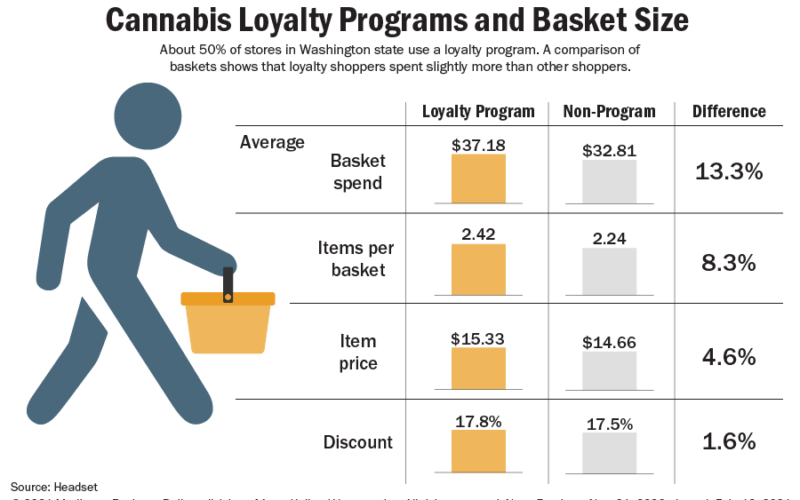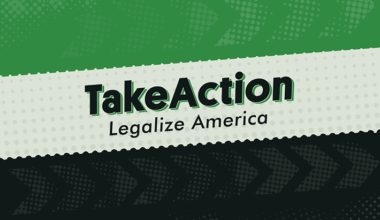Loyalty programs, long a staple of consumer marketing strategies, have found a place among regulated cannabis retailers in the United States and Canada.
By offering perks such as discounts, points, special offers and new-product notifications, retail operators say loyalty programs can be a useful tool for:
- Boosting basket sizes.
- Increasing the frequency of customer visits.
- Offering targeted marketing opportunities to age-verified shoppers, even when government regulations restrict marijuana promotions.
Offering those perks isn’t free, but loyalty-program operators say the benefits can easily outweigh the costs.
Data shows loyalty advantage
Recent figures provided by Seattle-based marijuana analytics firm Headset illustrate how loyalty programs can drive shopping habits.
Roughly 50% of cannabis stores in Washington state appear to use a loyalty program, according to Headset data analyst Cooper Ashley.
Over a 90-day period, the average basket spend among retailers with loyalty programs was $37.18 – 13% larger than the average spend at retailers without such a scheme.
Loyalty-program baskets also had more items per basket and slightly higher item prices.
“That’s a pretty significant advantage to having a loyalty program right there,” Ashley said. “Your customers tend to have larger transactions.”
Insights into customer behavior derived from loyalty programs can also be used to target promotions to a store’s most valuable customers.
“I think if a store is going through the effort of collecting customer data, the majority of the time, that’s going to be associated with a loyalty program,” Ashley said.
Clear loyalty benefits help drive sign-ups
In Las Vegas, Planet 13 offers a “Loyalty Member” program that’s accessible to out-of-state shoppers, with extra benefits for Nevada residents.
All loyalty-program participants get text-message notifications about daily deals and accrue reward points with purchases.
But Nevadans also get a 20% discount off regularly priced items and special promotional prices such as $25 eighths of select cannabis flower.
Only loyalty members get access to Planet 13 promotions such as daily deals, said David Farris, Planet 13’s vice president of sales and marketing.
“We do get a ton of people signing up just to really partake in the daily deals or the ongoing promos,” he said.
The benefits of the loyalty program are obvious enough that it doesn’t take much convincing to get customers to sign up, Farris added .
“I think all of us have been shoppers at retail stores, and everybody tries to get you to sign up,” Farris explained.
“And there’s not a lot of benefits, besides giving them your information – where I think here, you actually do get a lot of benefits if you’re a frequent purchaser.”
Communicating with loyalty customers
High Tide, a major Canadian cannabis retail chain with store brands that include Canna Cabana, operates a loyalty program called “Cabana Club.”
Chief Revenue Officer Andy Palalas said Canadian restrictions on using inducements to sell cannabis prevent High Tide from offering certain kinds of loyalty perks.
“We cannot, for example, say, ‘Hey, if you buy a certain amount of cannabis, you’re able to receive this extra amount of cannabis at a better price,’ nor can we incentivize that through points,” he said.
But other loyalty perks, such as a 5% discount off regularly priced products, are within bounds for High Tide.
Palalas said that simple discount helps drive in-store, loyalty-program sign-ups.
“There’s no accumulation of points, waiting (until your) next visit, none of that – it’s ‘Today, you can take 5% off your order if you sign up for the Club,’ and we find a lot of customers respond pretty well to that.”
However, the loyalty program’s critical purpose is “greater communication with our customers,” Palalas said.
“There are many new products that are coming out every day, and promotional activity is something that is challenging to telegraph out to customers outside of the dedicated channel with them.”
Cabana Club reaches customers via text message, with about one or two texts per week.
“They appreciate knowing things like when we’re getting new products in and when we’re getting restocked, etc.”
In a quarterly filing earlier this week, High Tide said its loyalty-program members spend, on average, 20% more than nonmembers.
“In general, they spend more and they visit more frequently,” Palalas said.
The cost of loyalty
Of course, it costs money to give customers discounts or points toward future purchases.
During the quarter ended Sept. 30, for example, Planet 13’s discounts and loyalty-points accruals were worth $1.3 million, against total revenue of $24.1 million.
Despite the cost, Planet 13’s Farris considers loyalty programs “a mandatory part of operating a business.”
“We believe customer service is who we are, and I think a part of that customer service is having a loyalty platform to keep them happy,” he said.
High Tide’s Palalas offered a similar perspective.
“I don’t think you could pay enough for a loyalty program, to be honest with you – it’s one of the most important pieces of your business,” he said.
For up-and-coming retailers, Palalas recommends launching a loyalty program right off the bat.
“Figuring out what you’re willing to provide to the customer as a benefit, in order to earn their trust so that you can communicate with them long term, is one of the first decisions you should make,” he said.
“You should make it before you start figuring out your margin profile, you should make that decision before you start figuring out what kind of products you’re going to carry,” Palalas continued.
“Because, ultimately, it ends up driving all of those decisions. As a new retailer, focusing on who your customer is and learning about them, and figuring out how best you can serve them, that’s the only thing you’re in business to do.”
Solomon Israel can be reached at [email protected].
Medical Disclaimer:
The information provided in these blog posts is intended for general informational and educational purposes only. It is not a substitute for professional medical advice, diagnosis, or treatment. Always seek the advice of your physician or other qualified healthcare provider with any questions you may have regarding a medical condition. The use of any information provided in these blog posts is solely at your own risk. The authors and the website do not recommend or endorse any specific products, treatments, or procedures mentioned. Reliance on any information in these blog posts is solely at your own discretion.







